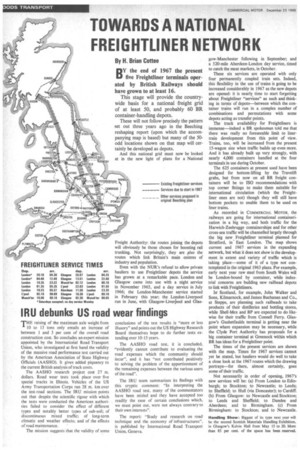TOWARDS A NATIONAL FREIGHTLINER NETWORK
Page 12

If you've noticed an error in this article please click here to report it so we can fix it.
By H. Brian Cotten
BY the end of 1967 the present five Freightliner terminals operated by British Railways should have grown to at least 16.
This stage will provide the countrywide basis for a national freight grid of at least 50, and probably 60 BR container-handling depots.
These will not follow precisely the pattern .set out three years ago in the Beeching reshaping report (upon which the accompanying map is based) but many of the 50odd locations shown on that map will certainly be developed as depots.
And this national grid must now be looked at in the new light of plans for a National
Freight Authority: the routes joining the depots will obviously be those chosen for boosting rail trunking. Not surprisingly, they are also the routes which link Britain's main centres of industry and population.
Even with the NUR's refusal to allow private hauliers to use Freightliner depots the service has grown at a remarkable pace. London and Glasgow came into use with a night service in November 1965, and a day service in July 1966; the London-Manchester service started in February this year; the London-Liverpool run in June, with Glasgow-Liverbool and Glas
gow-Manchester following in September; and a 520-mile Aberdeen-London day service, timed to catch the meat markets, in October.
These six services are operated with only four permanently coupled train sets. Indeed, this flexibility in the use of trains is going to be increased considerably in 1967 as the new depots are opened: it is nearly time to start forgetting about Freightliner "services" as such and thinking in terms of depots—between which the container trains will run in a complex number of combinations and permutations with some depots acting as transfer points.
The track availability for Freightliners is immense—indeed a BR spokesman told me that there was really no foreseeable limit to linertrain development from this point of view. Trains, too, will be increased from the present 15-wagon size when traffic builds up even more. And it has already built up very strongly, with nearly 4,000 containers handled at the four terminals in use during October.
The 625 containers at present used have been designed for bottom-lifting by the Travelift grabs, but from now on all BR freight containers will be to ISO recommendations with top corner fittings to make them suitable for international circulation (which the Freightliner ones are not) though they will still have bottom pockets to enable them to be used on liner trains.
As recorded in COMMERCIAL MOTOR, the railways are going for international containerization in a big way, and both traffic for the Harwich-Zeebrugge containerships and for other cross-sea traffic will be channelled largely through the big new Freightliner terminal planned for Stratford, in' East London. The map shows current and 1967 services in the expanding network, but what it does not show is the development in extent and variety of traffic which is taking place—some of it of a type not contemplated in the original 1963 plans. For example, early next year raw steel from South Wales will be London-bound by container, while industrial concerns are building new railhead depots to link with Freightliners.
Er Scotland, for example, John Walker and Sons, Kilmarnock, and James Buchanan and Co., at Stepps, are planning such railheads to take products of their distilleries and bottling stores, while Shell-Mex and BP are expected to do likewise for their traffic from Connell Ferry. Glasgow's Gushetfaulds terminal is getting near the point where expansion may be necessary, while the Clyde Port Authority has proposals for a big container terminal at Greenock within which BR has ideas for a Freightliner point.
The times of the present services are shown with the map. Times for 1967 services cannot yet be stated, but hauliers would do well to take a close look at the 1967 routes which the drawing portrays—for there, almost certainly, goes some of their traffic.
Not necessarily in order of opening, I967's new services will be: (a) From London to Edinburgh; to Stockton; to Newcastle; to Leeds; to Sheffield; to Hull (via Doncaster); to Cardiff. (b) From Glasgow: to Newcastle and Stockton; to Leeds and Sheffield; to Dundee and Aberdeen; and to Birmingham. (c) From Birmingham: to Stockton; and to Newcastle.
Handling Show: Biggest of its type next year will be the second Scottish Materials Handling Exhibition, in Glasgow's Kelvin Flail from May 15 to 20. More than 85 per cent, of the space has been reserved.












































































